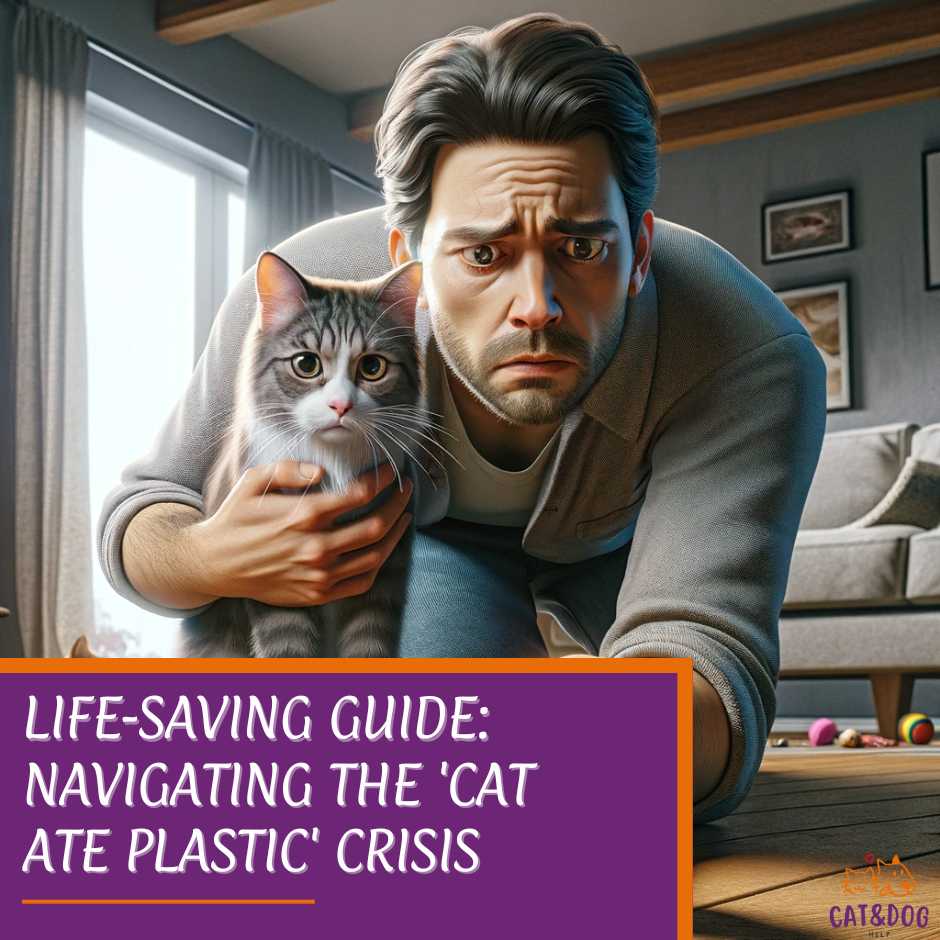Have you ever been puzzled by your cat’s quirky habits, especially when it comes to your cat ate plastic? It might be surprising to learn that plastic ingestion is not uncommon among our feline friends.
Curiosity can often lead cats into troublesome scenarios, and while it may seem like harmless exploration, the consequences can be quite serious.
If your cat accidentally chews or eats a piece of plastic or tinsel, you are undoubtedly worried that your buddy will suffer serious health complications, such as anemia or hyperthyroidism.
The severity of this situation is dependent upon the type of plastic eaten, making it important for us to understand and protect our curious creatures.
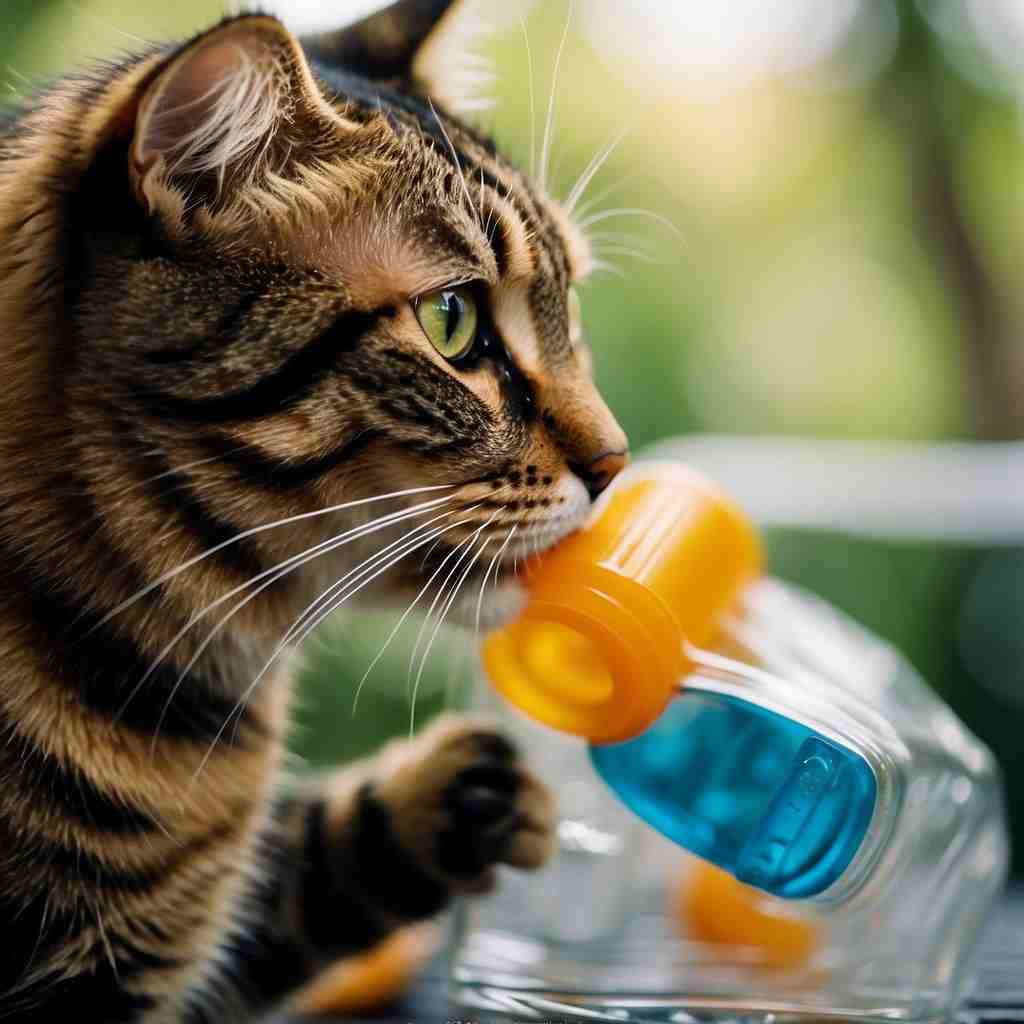
As a cat owner, it is important to recognize the signs of plastic ingestion quickly. Stress isn’t just a human experience; cats can also feel it, and strange eating habits may be a symptom of OCD.
Understanding why cats are attracted to plastic and taking immediate steps can prevent health complications.
By educating yourself about what to do when your furry companion decides that a piece of plastic looks tasty and addressing any potential lack of nutrients, you are ensuring their safety and peace of mind for yourself.
Like most negative behaviors, keeping your cat mentally stimulated and active will prevent boredom and reduce destructive behaviors, including the desire to eat non-food items like plastic.
Providing prey-mimicking toys and scratching spots can help satisfy their predator instinct and expel excess energy.
Additionally, ensuring a balanced and nutritious diet can also prevent your cat from seeking out non-food items as a source of nutrients.
Key Takeaways
- Plastic ingestion in cats can lead to serious health issues.
- Recognizing and acting swiftly on the signs of plastic ingestion is crucial.
- Understanding your cat’s behavior can help prevent future incidents.
Immediate Actions for Cat Ate Plastic
Emergency Response and First Aid
First things first: don’t panic. Now, let’s check your cat’s mouth:
- Gently open your cat’s mouth and look inside.
- If you spot a piece of plastic and it’s safe to do so, carefully remove it with your fingers.
- Avoid any sudden or forceful movements to prevent injury.
It’s really important to remember not to make your cat vomit unless you’ve got the go-ahead from your vet. This could do more harm than good.
Symptoms to Watch For
Let’s stay vigilant for any alarming signs. Keep an eye out for:
- Choking or difficulty breathing: If your cat’s airway seems compromised, time is of the essence. (1)
- Lethargy or collapse: This could mean trouble and warrants immediate veterinary attention. (2)
- Changes in behavior or eating habits: Not their usual self? Let’s get them checked. (3)
If any of these make an unwelcome appearance, reach out to your vet pronto. They’ll provide the professional advice and care your pal needs.
Remember, when it comes to our curious kitties, it’s always better to be safe. So, take a deep breath, assess the situation, and seek veterinary help if you’re concerned. We’ve got this!
Expert Advice on Plastic Ingestion
Immediate Steps:
- Remove any plastic remnants: Prevent further chewing.
- Observe for symptoms: Vomiting, diarrhea, lethargy, or stomach pain.
- Call your vet: They’ll likely want to know the type and amount of plastic ingested.
“Most cats do well with prompt treatment,” vets often say. They might induce vomiting, or in more severe cases, surgery could be necessary to remove the blockage.
When It’s an Emergency:
Seek veterinary care if you notice:
- Persistent vomiting
- Difficulty breathing
- Changes in behavior
- Signs of distress
Remember, some plastics can be more sinister, hiding toxins or causing suffocation. Regular check-ups post-incident are crucial for tracking your kitty’s recovery.
Veterinarians Suggest:
- Prevention is key: Keep plastics out of paw’s reach.
- Quality diet: It might reduce the craving for non-food items.
- Behavioral enrichment: Engage your cat in play to deter them from undesirable munching.
In the end, keep your vet’s number handy, be it a mishap after their curiosity got the better of them or just to ask, “How to stop my cat from auditioning for the next plastic-chewing circus?” Stay vigilant, stay prepared, and give your feline companion the best care you can.
Understanding Why Cats Eat Plastic
Cats are inherently curious and often turn to non-food items to explore their environment. This is part of their playfulness, and sometimes they may lick or chew objects to learn about them.
Here are a few insights into this behavior:
- Sensory Attraction: Some plastics are coated with substances like cornstarch or have remnants of food scents, which might be irresistible to your kitty’s keen sense of smell and taste. (4)
- Nutritional Deficiency: Though it’s less common, some experts suggest that an inadequate diet might lead some cats to seek out other materials for nutrients. (5)
- Pica: This is a condition where cats eat non-food items. If your pet’s plastic-eating habit is consistent, it’s worth a vet check to rule out any underlying issues. (6)
- Boredom or Anxiety: Just like people, cats can get bored or anxious, leading them to chew on plastic items as a coping mechanism. (7)
Let’s not forget that each cat is an individual, and some breeds are more prone to these behaviors.
You might wonder, “Is my cat fabricating their toys?” In a sense, yes, that crinkly plastic sound could be as enticing as a store-bought toy for them!
So, if you find your cat treating a plastic bag like a snack, it’s not them being quirky—it’s a call for you to understand and ensure their well-being.
Remember, plastic poses risks like choking or blockages, so keep those plastic items away from your curious companion!
Note: This behavior varies and is not inherently dangerous unless it leads to the consumption of plastic, which can be harmful. Always consult a vet if you’re concerned about your cat’s habits.
Preventive Measures and Solutions
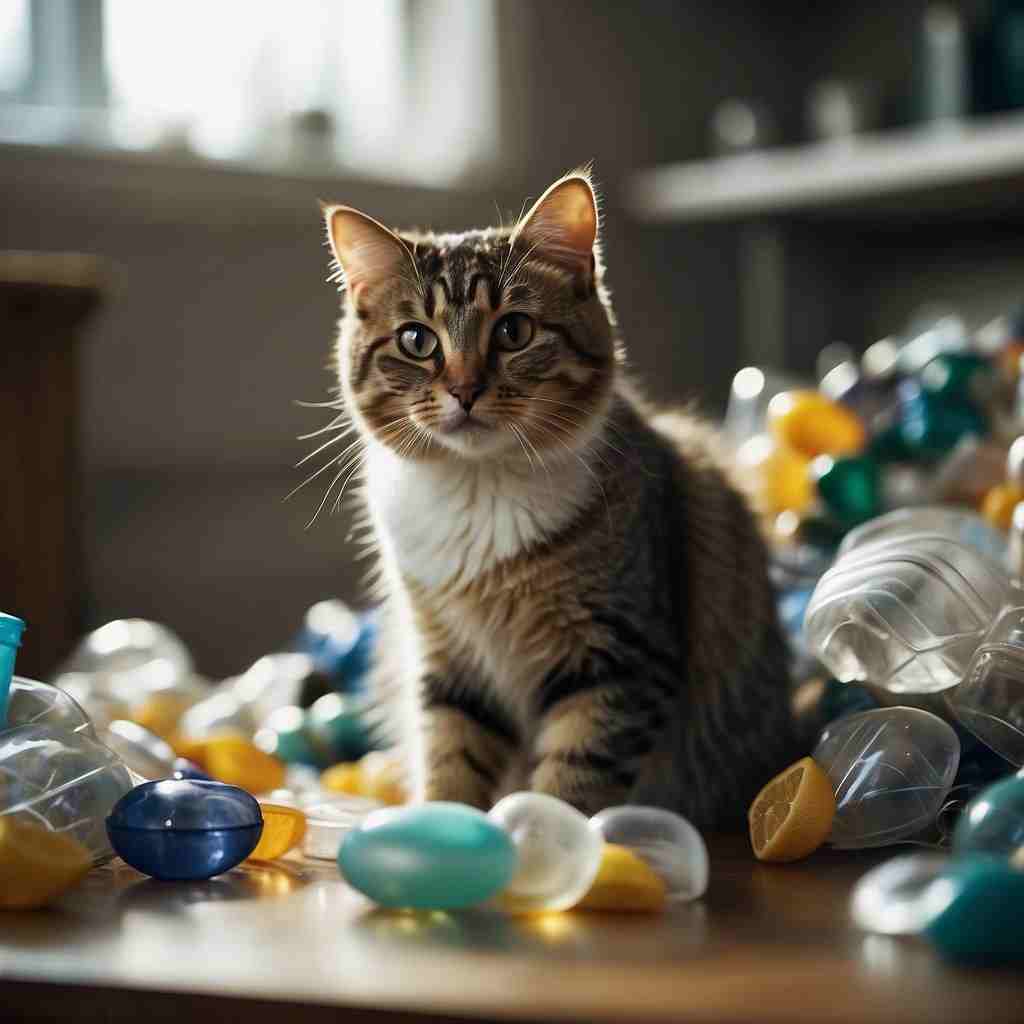
Cat-Proofing Your Home
Have you ever found your cat chewing on a plastic bag? It’s a common scenario, but one that can be prevented. Consider the following steps:
- Safe Storage: Keep plastic items like bags, wrappers, and packaging out of paws’ reach. Use cabinets with secure latches or high shelves.
- Alternatives: Swap out plastic items for safer options whenever possible—think metal or glass food storage containers over plastic ones.
Behavioral Training to Prevent Future Incidents
Your furry friend is smarter than you might think, and a little training goes a long way. Here are some tips:
- Deterrents: Double-sided tape or aluminum foil can discourage your cat from certain areas or items due to their texture.
- Positive Reinforcement: Caught your cat ignoring plastic? Reward them! Treats or affection can reinforce good behavior.
Remember, keeping plastic from your cat is not just about being tidy; it’s about their health. No more “purrr-tastic” plastic adventures! Your cat’s tummy will thank you.
Long-Term Health Implications
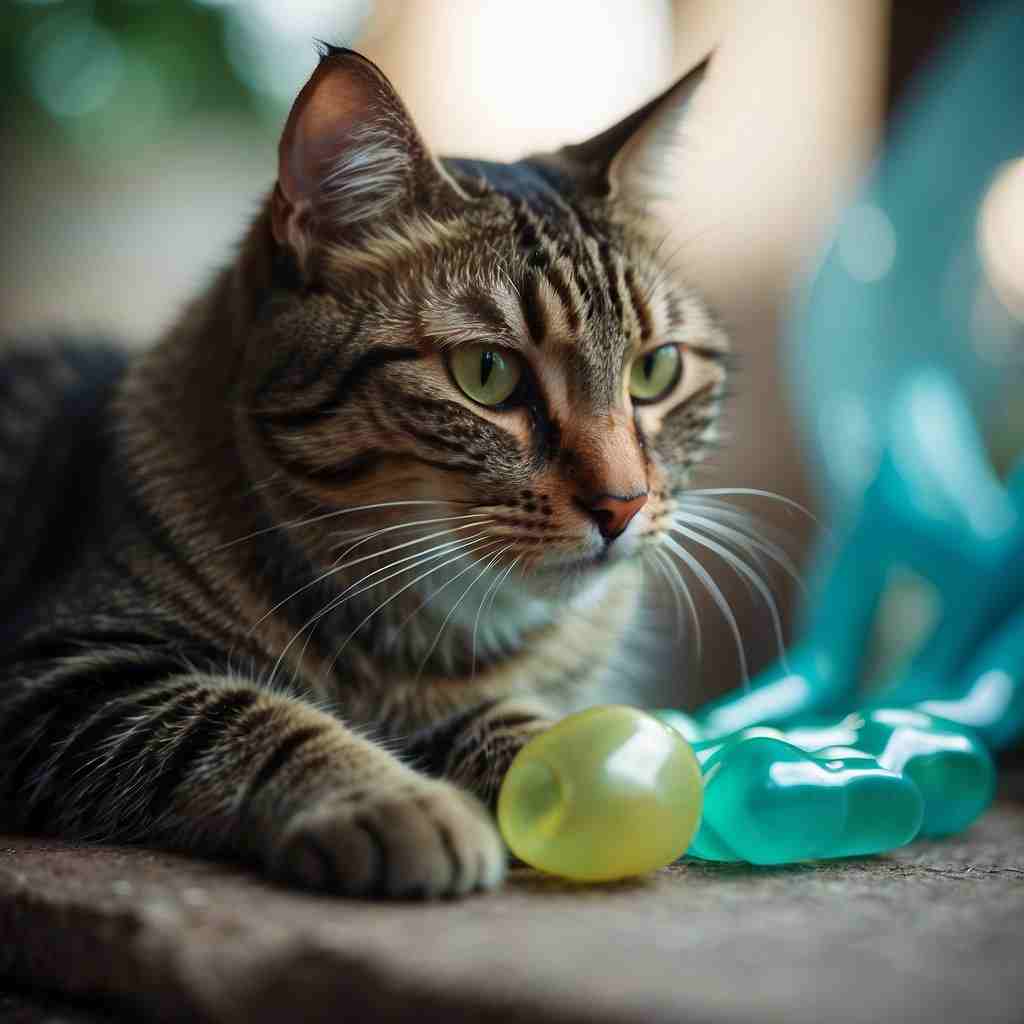
Intestinal Blockage: This is a big one. Your cat’s gastrointestinal tract is as delicate as it is efficient, and sharp plastic can throw a wrench into the works.
If plastic pieces get stuck in there, they can cause blockage, leading to a slew of unhappy symptoms like vomiting, constipation, inflammation, or worse, an emergency trip to the vet.
So, if you notice your cat has skipped a meal or two, or their litter box remains spotless a little too long, it’s worth checking in on the state of your cat’s digestive tract, specifically the small intestine, for any potential physical obstructions caused by ingesting sharp fragments of plastic or poop.
In severe cases, this blockage can lead to a life-threatening condition called pancreatitis, where the pancreas becomes inflamed and can cause serious complications.
It is important to seek immediate veterinary care if you suspect your cat has ingested plastic and assess your cat’s condition for any potential long-term health implications, including evidence of a blockage or damage to the gut lining and cat’s organs.
- Symptoms to Watch For Vomiting (8)
- Constipation (9)
- Lack of appetite (10)
- Lethargy
- Visible abdominal discomfort (11)
Poisoning: Although less common, it’s a real concern. Some plastics are coated with chemicals that may be harmful if ingested.
A plastic chew session can lead to toxins being released into your cat’s system. Let’s keep a lookout for any out-of-the-ordinary behavior that could clue us in on potential poisoning.
Remember, the key to keeping your kitty out of trouble is vigilance.
You can prevent a whole host of issues by making sure plastics are out of paw’s reach and offering safer alternatives for chewing, such as different types of cat toys.
After all, an ounce of prevention is worth a pound of cure. Keep it safe, and your whiskered companion will thank you with purrs and head bunts galore!
Don’t forget to offer a variety of types of toys to keep your cat entertained and satisfied.
In-Depth: Types of Plastic and Risks
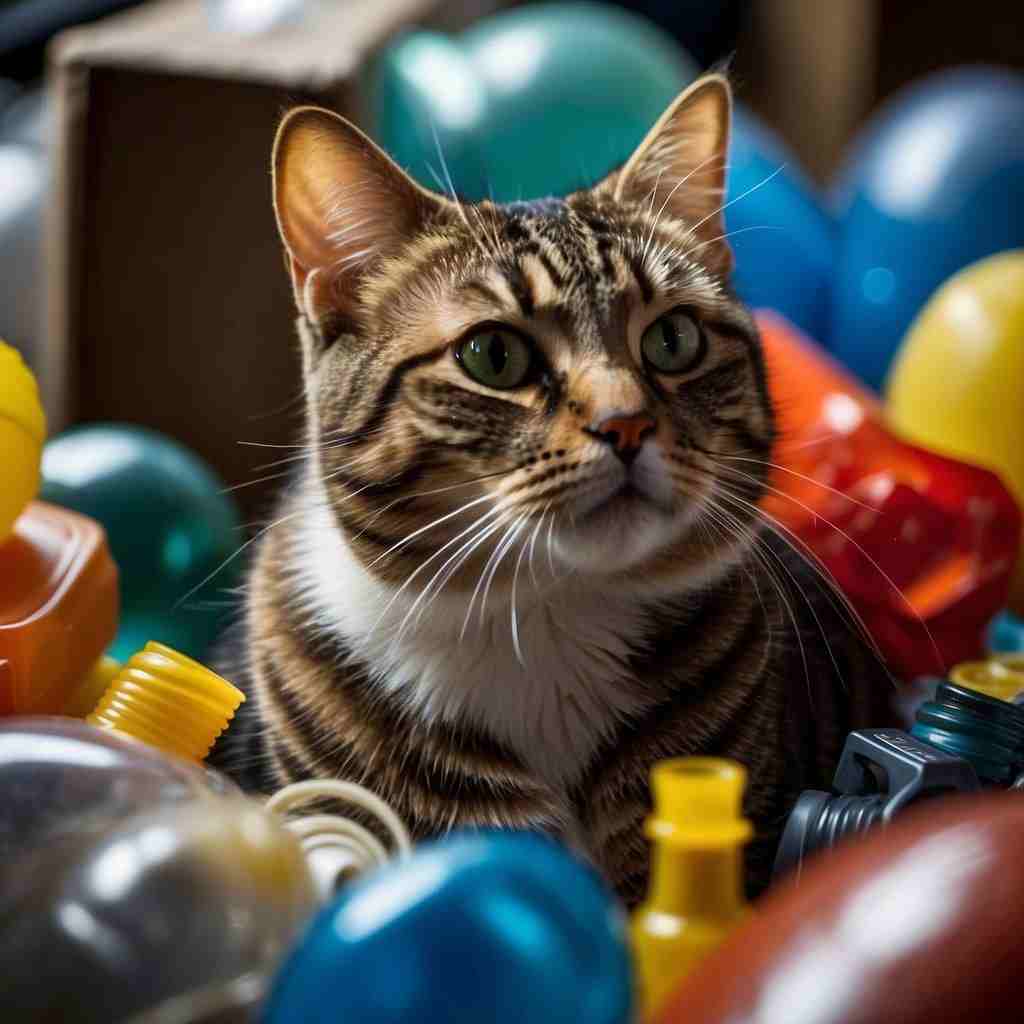
Soft Plastics
These include plastic bags, wrappers, and films. Cats might love the crinkly sound, but consuming these can lead to:
- Choking hazards: Ever seen a cat play with a plastic bag? It’s like watching a toddler with a new toy, except it’s less “Aww!” and more “Oh no!”
- Intestinal blockage: Soft plastics can easily become balled up inside your kitty, causing constipation or even a life-threatening situation. (12)
Hard Plastics
Think bottle caps, plastic toys, and utensils. These guys are tougher, and the risks here include:
- Dental damage: Your cat’s chompers aren’t made for gnawing on hard objects. Doing so can lead to cracked teeth or other dental issues. (13)
- Internal injuries: Hard plastics can cause scratches or perforations in the digestive tract if your furry adventurer decides to go on a plastic-eating spree. (14)
Given that, what can you do to keep your cat safe? Well, for starters, keep those pesky plastic items out of reach.
And how about providing some safer playthings? Cat trees, feather wands, and puzzle feeders can distract your cat from those not-so-tasty plastic treats.
Remember, curiosity may not kill the cat, but the plastic just might. Let’s keep those curious paws—and tummies—safe!
Real-Life Examples and Case Studies
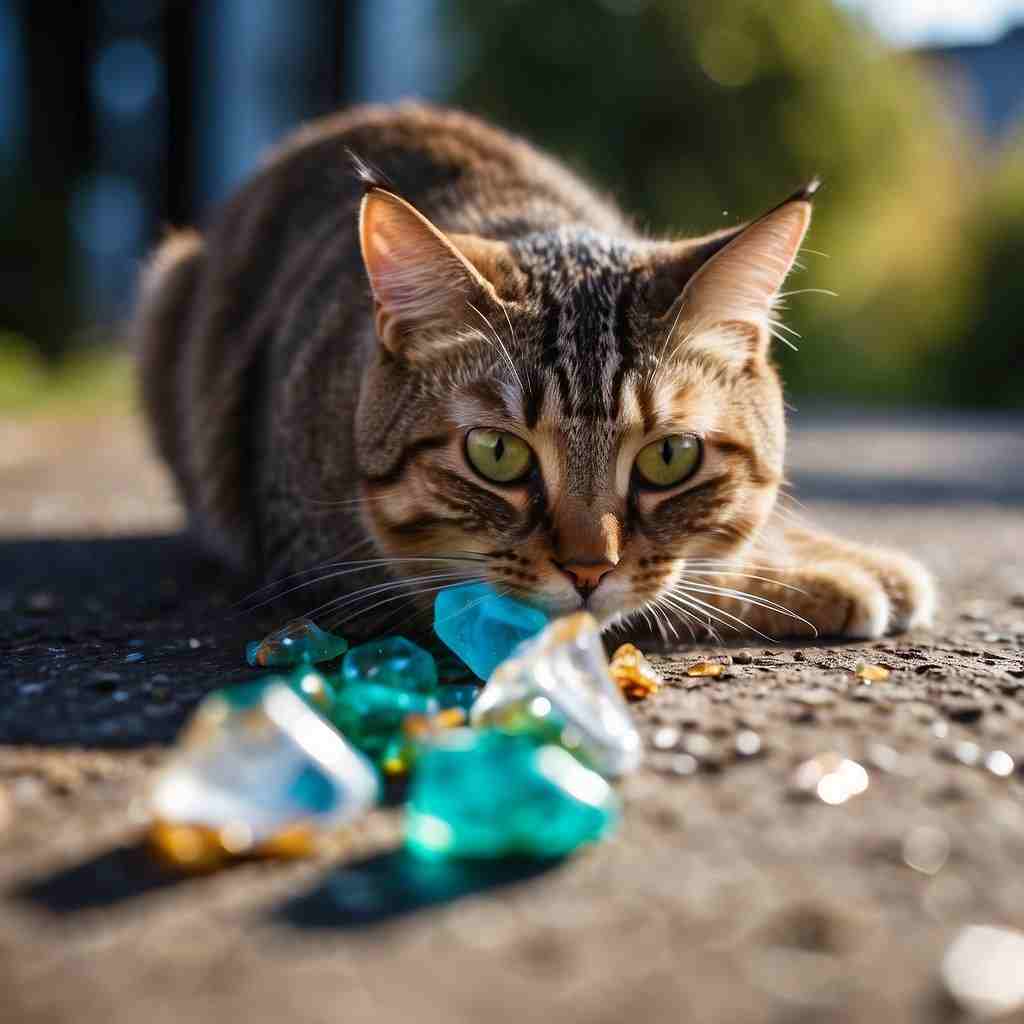
Case Uno: The Candy Wrapper Bandit
What happened?
In this hair-raising tale, Tuna, a six-month-old Siamese, snuck a candy wrapper. Not the best treat!
Lesson Learned
Quick action was key. Tuna’s parents noticed her odd behavior early and rushed her to the vet where an X-ray confirmed the wrapper’s location.
Case Two: The Bag Biter
Symptoms:
An older tabby, Whiskers, found a plastic grocery bag. A nibble here and a nibble there led to decreased appetite and distress.
Outcome:
Veterinary intervention was crucial. Although Whiskers required surgery to remove the blockage, she recovered fully thanks to her owner’s swift decision to seek help.
Fast Fact Check:
- Common Symptoms: Loss of appetite, vomiting, diarrhea, lethargy.
- Key Action: Contact your vet if you suspect your cat has ingested plastic.
- Statistics Spotlight: No precise numbers, but these incidents are more common than we wish!
Remember, if your cat’s latest toy is your shopping bag or any plastic item – it’s serious. Keep an eye out for symptoms and don’t hesitate to call your vet if something seems off.
You know your cat best and your timely response can make all the difference. Stay informed, and keep those plastic bags away from prying paws!
Quick Recap
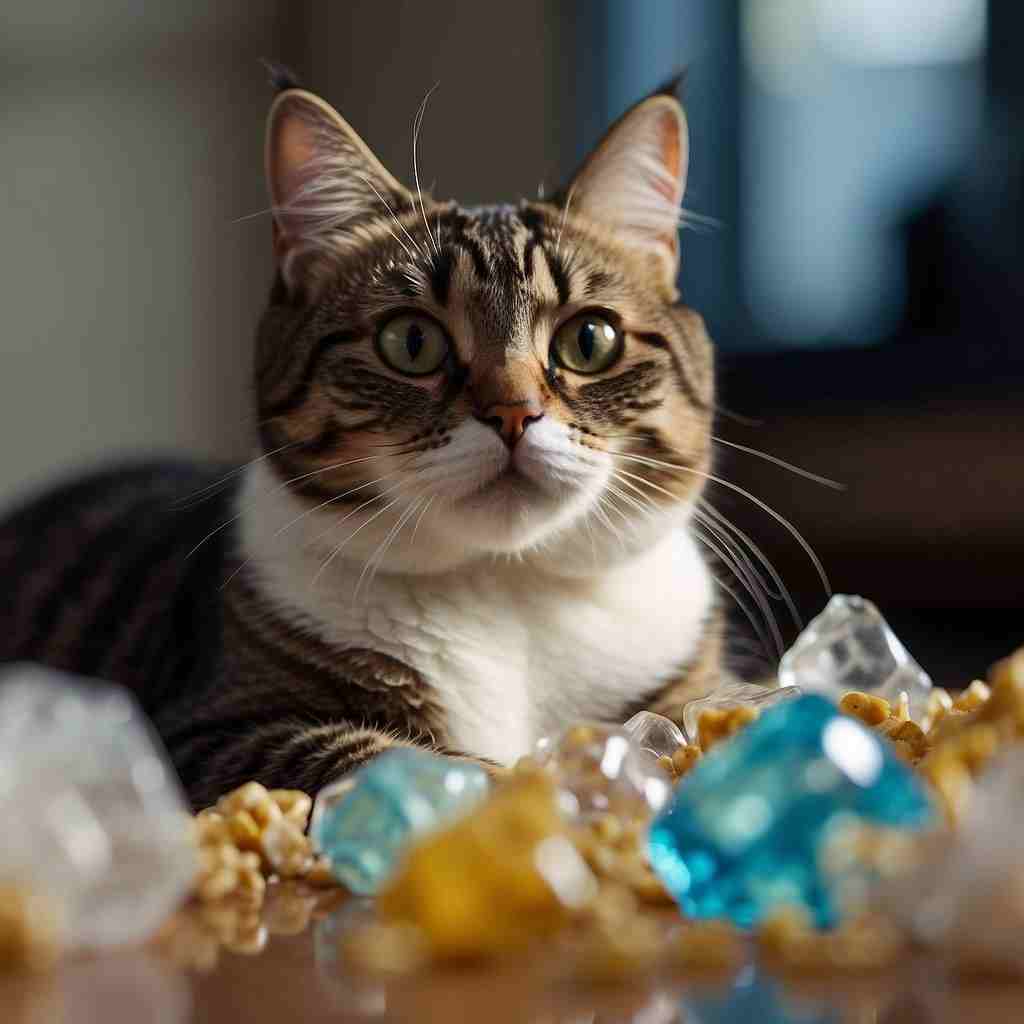
- Notice Early Symptoms: Keep an eye out for signs like lethargy, vomiting, diarrhea, or abdominal discomfort. Cats are stealthy, but these clues can give away their plastic-munching misadventures.
- Immediate Action: If you catch your cat in the act or suspect they’ve ingested plastic, limit their access to any more of it. Observe your cat closely for any abnormal behavior or signs of distress.
- Be Proactive with Vet Visits: When in doubt, it’s better to be safe and schedule a vet visit. A professional can give you peace of mind and ensure your feline friend remains healthy.
Prevention is Key:
- Secure Plastic Items: Cats can be like ninjas when it comes to finding plastic, so ensure that all plastic items are secured and out of reach.
- Enrichment Toys: Distract your cat with engaging toys that are far more interesting (and safer) than any plastic bag or wrapper.
Table 1: Quick Actions and Preventive Measures
| If Your Cat Ate Plastic | Preventive Measures |
| Observe for any symptoms | Secure all plastics |
| Limit access to more plastic | Offer engaging toys |
| Visit the vet if needed | Regularly check for pica-related behavior |
Remember, no one knows your little furball better than you do. Trust your instincts—if something seems off, a vet check-up might just be the way to go.
And who knows, this could be the purr-fect time to spoil your cat with some new, safe chew toys! Keep those plastics away and keep your kitty play safe.
Frequently Asked Questions
Cats are known for their curiosity, which can sometimes lead them to eat things they shouldn’t—like plastic. If your kitty has gotten into mischief with plastic, you probably have questions.
Let’s tackle some of the most common concerns cat owners have when it comes to this chewy predicament.
How can I tell if my cat is in danger after eating plastic?
If your cat suddenly becomes lethargic, starts vomiting, has diarrhea, or displays a lack of appetite, these may be signs that the eaten plastic is causing an obstruction or other health issues.
Look out for any unusual behavior and be ready to contact your vet.
Can I give my cat any home treatment if it eats plastic?
Home treatment isn’t recommended without a vet’s advice, as plastic could cause internal damage or blockages.
It’s best to observe your cat closely and consult with a vet who may provide guidelines specific to your cat’s situation.
What should I do if my feline friend nibbles on a plastic wrapper?
Firstly, don’t panic.
Remove any remaining plastic to prevent further ingestion. Keep an eye on your cat for any signs of distress and consult with your vet for the best course of action.
Are there any emergency steps to take when puss eats plastic and shows distress?
If your cat is showing clear distress after eating plastic, such as choking, gasping, or struggling to breathe, it’s best to go to an emergency vet immediately.
Always keep your vet’s emergency number handy.
Why do cats eat plastic and how can I prevent it?
Cats may be attracted to the crinkly noise or the texture of plastic bags. To discourage this, provide plenty of safe toys and keep plastic out of reach.
Also, for some cats, this behavior might indicate boredom, so make sure to give your furry friend enough playtime.
Does a plastic-eating habit indicate any underlying health issues in cats?
In some cases, yes.
If your cat frequently eats non-food items, this could be a sign of a condition called pica, which may stem from nutritional deficiencies, anxiety, or medical issues.
If this behavior is persistent, a vet visit is warranted to rule out these concerns.
- Where to find the most trustworthy real money casinos - August 7, 2025
- Online Casinos That Approve PayPal: The Ultimate Overview - August 7, 2025

